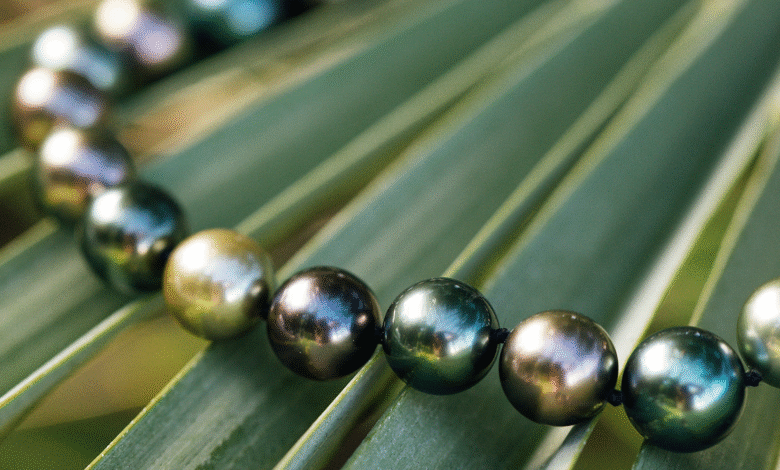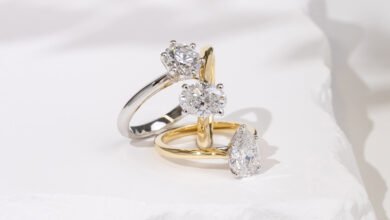Midnight Oceans: The Complete Guide to Tahitian Pearls

Introduction
Tahitian pearls often called “black pearls” are among the most striking and desirable cultured pearls in the world. Grown primarily in the lagoons of French Polynesia, these pearls are celebrated for their exotic dark hues that range from charcoal and peacock green to deep purples and silvery grays. Unlike freshwater or typical Akoya pearls, Tahitian pearls come from the black-lipped oyster (Pinctada margaritifera), which gives them their distinctive color palette. Whether you’re a first-time buyer, a jewelry professional, or a curious reader, understanding what makes Tahitian pearls unique how they’re formed, graded, and maintained helps you appreciate their value and longevity. This article follows Google’s E-E-A-T principles by explaining technical details clearly, offering practical buying and care advice, and presenting information useful to both consumers and sellers.
What are Tahitian pearls?
Tahitian pearls are cultured pearls produced by the black-lipped pearl oyster in the warm, nutrient-rich waters of French Polynesia and a few surrounding islands. The term “Tahitian” reflects their primary region of cultivation rather than the pearl’s exact color; while many are dark, some display lighter or metallic overtones. These pearls are formed when a nucleus and a small piece of mantle tissue are surgically implanted into the oyster. Over months to years, the oyster secretes layers of nacre around the nucleus, producing a pearl. Their natural color results from the oyster’s pigment interacting with nacre layers, creating overtone effects such as peacock (green/blue), aubergine (deep purple), and silver. Because of their size, rarity, and dramatic colors, Tahitian pearls are often used in high-end jewelry pendants, statement necklaces, and designer pieces and are prized for their bold, contemporary aesthetic.
How are Tahitian pearls formed and farmed?
Tahitian pearl formation begins with careful selection of healthy black-lipped oysters in hatcheries and nurseries located in lagoons. Technicians perform a grafting procedure: they implant a round nucleus (usually a bead) and a tiny piece of donor mantle tissue into the oyster’s gonad. The oyster then deposits nacre in concentric layers around the nucleus. Farming conditions water temperature, plankton supply, and the skill of the technicians directly affect nacre quality and the pearl’s final color and luster. Culturing takes from 18 months to four years depending on desired size and quality. Farmers periodically nurture oysters, protect them from predators, and move them to varied depths to optimize nacre deposition and reduce blemishes. Sustainable practices are increasingly emphasized. Responsible farms use site rotation, oyster health monitoring, and local community involvement to preserve the lagoon environment and ensure long-term production of high-quality Tahitian pearls.
Characteristics and grading
Tahitian pearls are graded on familiar pearl-quality criteria color, size, luster, surface, and shape but their color and overtone complexity make grading slightly more specialized. Color refers to the body color (dark gray, black, green, etc.), while overtone describes a secondary hue that appears on the surface (peacock, aubergine, silver). Luster how sharply the pearl reflects light is a prime determinant of value; high-grade Tahitian pearls show crisp, mirror-like reflections. Size matters: Tahitian pearls commonly range from 8 mm to over 16 mm, with larger, perfectly round examples commanding premium prices. Surface quality evaluates blemishes or irregularities fewer surface flaws increase desirability. Shape categories include round, near-round, drop, button, and baroque perfectly round Tahitians are rare and top-priced. When assessing a pearl, experts weigh all these factors: a medium-sized pearl with exceptional luster and clean surface may outvalue a larger, duller specimen with many marks.
Buying tips, authenticity, and caring for Tahitian pearls
When buying Tahitian pearls, prioritize luster and surface quality over size alone. Buy from reputable jewelers who provide clear grading information and, if possible, a certificate from an independent gemological lab stating origin and treatment status. Beware of surface-treated or dyed pieces; while some treatments are accepted in trade, full disclosure is essential. Ask about the farm of origin and the pearl’s nacre thickness: thicker nacre means better longevity. For care, pearls are organic avoid chemicals, perfumes, and ultrasonic cleaners. Wipe pearls gently with a soft, slightly damp cloth after wear and store them separately in a soft pouch to prevent scratches. Restring pearl necklaces periodically (every 1–3 years depending on wear) on silk with knots to prevent loss if the strand breaks. Proper care preserves both beauty and value, keeping Tahitian pearls wearable heirlooms for generations.
Conclusion
Tahitian pearls combine natural rarity with dramatic beauty, offering a bold alternative to classic white pearls. Their distinctive colors, impressive sizes, and deep luster make them a favorite for statement and designer jewelry. Whether you’re buying a first piece or expanding a fine jewelry collection, focus on luster, surface quality, and authenticity. Choose trusted sellers who follow transparent practices and provide grading or certification when possible. With careful care gentle cleaning, safe storage, and routine restringing Tahitian pearls can maintain their allure and monetary value for many years. These luminous gems are not only objects of adornment but also reflections of skilled farming practices and the delicate ecosystems that produce them.
FAQs
Q1: Are Tahitian pearls always black?
No. “Tahitian” refers to their origin and oyster species, not strictly to color. They’re famous for dark and metallic hues, but can show gray, silver, green, peacock, and purple overtones.
Q2: How can I tell if a Tahitian pearl is real?
Look for high luster, natural overtone complexity, and slight surface irregularities. Real cultured pearls have depth and satiny reflections; request documentation from the seller and consider lab certification for high-value purchases.
Q3: Do Tahitian pearls require special care compared to other pearls?
Care is similar: avoid chemicals, wipe after use, store separately, and restring necklaces periodically. Their slightly harder nacre makes them durable, but they remain organic and need gentle treatment.
Q4: Are baroque Tahitian pearls less valuable than round ones?
Not necessarily. While perfectly round pearls command premiums, unique baroque shapes can be highly sought after for artistic and bespoke jewelry, sometimes commanding high prices depending on luster and surface.
Q5: Is origin important when buying Tahitian pearls?
Yes. Genuine Tahitian pearls are primarily from French Polynesia. Origin affects value and authenticity; reputable sellers should disclose origin and provide transparency about treatments or enhancements.



